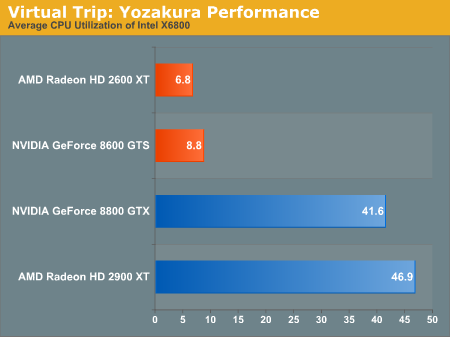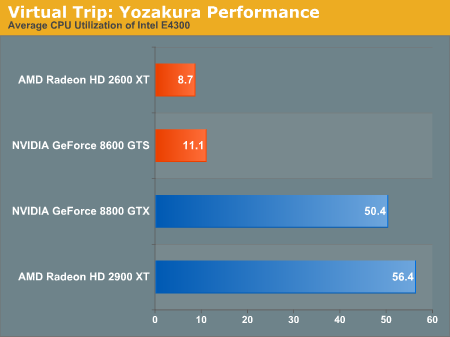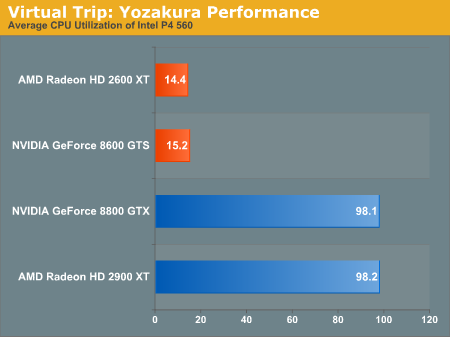HD Video Decode Quality and Performance Summer '07
by Derek Wilson on July 23, 2007 5:30 AM EST- Posted in
- GPUs
Yozakura (High Complexity H.264) Performance
H.264 offers quite a range of options, and we haven't seen everyone taking advantage of some of the more advanced features. Yozakura is encoded in 1080i at 25 Mbps. This is fairly low for H.264 maximums, but this is still very CPU intensive because the video is encoded using macroblock adaptive frame/field (MBAFF) coding. MBAFF is a high quality technique to ensure maximum visual fidelity in interlaced video by adaptively selecting frame or field encoding per macroblock based on a motion threshold.
While 1080p is clearly Hollywood's choice of resolution, there is 1080i encoded content out there now and more likely to come. As TV shows transition to HD, we will likely see 1080i as the choice format due to the fact that this is the format in which most HDTV channels are broadcast (over-the-air and otherwise), 720p being the other option. It's nice to know that H.264 offers high quality interlaced HD encoding options, and we hope content authors who decide to release their creations in 1080i will take advantage of things like MBAFF.
Additionally, good deinterlacing is essential for getting a good experience with movies like this. Poorly deinterlaced HD content is not only sad to watch, but gives this author quite a headache. Jaggies and feathering are horrible distractions at this resolution. As long as you stick with an HD 2600 or GeForce 8600 series or higher you should be fine here. Any slower just won't cut it when trying to watch 1080i on a progressive scan display.

Our high end CPU is able to cope fairly well, with the 8800 GTX besting the 2900 XT in performance while UVD leads VP2 putting the 2600 XT ahead of the 8600 GTS.

For our cheap yet current processor, we do see utilization go up, but the hardware with bitstream decoding maintains very low overhead. All of our GPUs maintain good performance when paired with this level of processor. Of course, we would likely not see the high end GPUs matched with such a CPU (unless we are looking at notebooks, but that's a whole other article).

For our older hardware, Yozakura is simply not watchable without bitstream decoding. With the numbers for the high end AMD and NVIDIA GPUs even worse than under our Transporter 2 trailer test, it's clear that NetBurst does not like whatever Yozakura is doing. It may be that decoding the bitstream when MBAFF is used is branch heavy causing lots of stalls. All we can say for sure is that, once again, GPU accelerated bitstream decoding is necessary to watch H.264 content on older/slower hardware.
H.264 offers quite a range of options, and we haven't seen everyone taking advantage of some of the more advanced features. Yozakura is encoded in 1080i at 25 Mbps. This is fairly low for H.264 maximums, but this is still very CPU intensive because the video is encoded using macroblock adaptive frame/field (MBAFF) coding. MBAFF is a high quality technique to ensure maximum visual fidelity in interlaced video by adaptively selecting frame or field encoding per macroblock based on a motion threshold.
While 1080p is clearly Hollywood's choice of resolution, there is 1080i encoded content out there now and more likely to come. As TV shows transition to HD, we will likely see 1080i as the choice format due to the fact that this is the format in which most HDTV channels are broadcast (over-the-air and otherwise), 720p being the other option. It's nice to know that H.264 offers high quality interlaced HD encoding options, and we hope content authors who decide to release their creations in 1080i will take advantage of things like MBAFF.
Additionally, good deinterlacing is essential for getting a good experience with movies like this. Poorly deinterlaced HD content is not only sad to watch, but gives this author quite a headache. Jaggies and feathering are horrible distractions at this resolution. As long as you stick with an HD 2600 or GeForce 8600 series or higher you should be fine here. Any slower just won't cut it when trying to watch 1080i on a progressive scan display.

Our high end CPU is able to cope fairly well, with the 8800 GTX besting the 2900 XT in performance while UVD leads VP2 putting the 2600 XT ahead of the 8600 GTS.

For our cheap yet current processor, we do see utilization go up, but the hardware with bitstream decoding maintains very low overhead. All of our GPUs maintain good performance when paired with this level of processor. Of course, we would likely not see the high end GPUs matched with such a CPU (unless we are looking at notebooks, but that's a whole other article).

For our older hardware, Yozakura is simply not watchable without bitstream decoding. With the numbers for the high end AMD and NVIDIA GPUs even worse than under our Transporter 2 trailer test, it's clear that NetBurst does not like whatever Yozakura is doing. It may be that decoding the bitstream when MBAFF is used is branch heavy causing lots of stalls. All we can say for sure is that, once again, GPU accelerated bitstream decoding is necessary to watch H.264 content on older/slower hardware.










63 Comments
View All Comments
TA152H - Monday, July 23, 2007 - link
Just my opinion, but I would save money on the Power DVD if you are buying ATI and just use theirs. Power DVD is not cheap, and I personally do not like it is much, but I am sure others do. He has to use it, of course, because how else would he be able to test Nvidia and ATI on the same software. But it's not a trivial expense, and the ATI stuff works well enough that it seems, to me, an unnecessary expense. You might be happier with spending that money on hardware instead of Power DVD. Again, all this assumes an ATI card purchase.phusg - Monday, July 23, 2007 - link
Good questions. From what I've seen the 2600 Pro is the least power hungry card at under 50W. Any chance you could shed some light Derek?TA152H - Monday, July 23, 2007 - link
Choosing a Pentium 4 560 is a really strange choice, do you think there are a lot of them out there with PCI-E waiting to upgrade to one of these cards. It's a minor point, but I think a Pentium D 805 would have been an excellent choice, since a lot of people bought these and it would be a much more interesting data point, and many of them on PCI-E based motherboards.My next point is the expectation of the 2900 XT. I totally disagree this is something they needed to add, because what they are saying is absolutely true. Someone who will buy this item will almost certainly do it with a very capable CPU. Since high end processors are dual cores, it is not as if you can not do something else if the CPU is assisting with it. It's not free, you pay for it with cost, and you pay for it with power use, and you pay for it to heat, and it's going to be a waste the vast majority of time. Considering the power use of the 2900 is appalling already, adding to this is highly undesirable considering the very questionable usefulness of it.
I think they should be congratulated for using intelligent feature targeting for their products, rather than bloating a product with useless features and making people pay for it.
johnsonx - Tuesday, July 24, 2007 - link
Clearly, the point was to get a single-core point of reference. While admittedly that exact CPU would be a slightly rare case, it's a simple matter to benchmark it since it fits the same 775 mainboard as the two Core2 chips. A PD805 wouldn't be much use to compare, as it would simply be a bit slower than the E4300... so what? The P4 560 makes a reasonable proxy for the variety of good performing single-core P4's and Athlon64's out there, while the E4300 stands in for all the X2's.TA152H - Tuesday, July 24, 2007 - link
Are you crazy?The Pentium D 805 is a very popular chip and widely used, and represents an entirely different architecture. It would be an extremely valid data point because it's a popular item. It's not "a little slower", it has completely different performance characteristics.
A Pentium 560 owner will probably never buy this card, and many of these owners are not even on a PCI-E platform. I wouldn't even have had a problem if they sold a single core Sempron, but a Pentium 560 makes no sense at all. People are still buying the 805, in fact, and you don't think the idea of popping one of these cards with an 805, while waiting for the Penryn to come out, is not something people think about? Or a similar Pentium D? Except, they'll not know how it performs. Luckily, though, they'll know how the Pentium 560 performs, because, I'm sure, that is their next choice.
100proof - Monday, July 23, 2007 - link
Derek,Seeing as this is an article concerning media decoding with an emphasis towards HD media playback, shouldn't Anandtech be applying some pressure on Nvidia to support open drivers for linux? mythTV and XBMC are promising HTPC options, perfectly suited towards this test scenario.
Why should h.264 offloading be exclusive to users of Microsoft operating systems?
100proof - Monday, July 23, 2007 - link
This complaint applies to ATi\AMD as well.erwos - Monday, July 23, 2007 - link
Linux doesn't have a framework to support H.264 or VC-1 acceleration yet. When that happens, I would expect the binary drivers to catch up fairly quickly.smitty3268 - Monday, July 23, 2007 - link
Actually, it does. The problem is that it is open source, while the MS equivalent is closed. ATI/NVIDIA don't want to share their specs in an open manner and never came up with a suitable API to make public.wien - Monday, July 23, 2007 - link
Well, gstreamer allows for closed source plug-ins since it's licensed under LGPL. Fluendo has already implemented a lot of proprietary (patented) codecs in gstreamer. With the required features exposed through the driver, it shouldn't be too hard for the IHVs to do the same with hardware accelerated H.264/VC-1.It's probably not worth their time yet though...